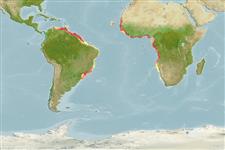>
Scombriformes (Mackerels) >
Centrolophidae (Medusafishes)
Etymology: Schedophilus: Name from Greek words 'phylos' (Φίλος), t) meaning 'one who likes' and "s 'shedia' (Σχεδία) which means raft; literally means 'the one who likes rafts'. This probably refers to the lifestyle ot the juveniles of this genus (Michail Ragousis, mar10091@marine.aegean.gr, pers. Comm. 01/16) which are epipelagic and associate with floating jellyfish.
More on author: Poll.
Environment: milieu / climate zone / profondeur / distribution range
Écologie
marin benthopélagique; profondeur 50 - 500 m (Ref. 2683), usually 100 - 500 m (Ref. 26999). Deep-water; 21°N - 29°S, 71°W - 16°E
Eastern Atlantic: Cape Blanc, Mauritania to the Kunene River, Angola. Reported from Namibia (Ref. 27121). Western Atlantic: occurrence in Venezuela is based on 4 samples taken from the coast, of which only one is larger than 20 cm TL (Ref. 13628).
Taille / Poids / Âge
Maturité: Lm ? range ? - ? cm
Max length : 50.0 cm TL mâle / non sexé; (Ref. 2683); common length : 30.0 cm TL mâle / non sexé; (Ref. 2683)
Épines dorsales (Total) : 5 - 7; Rayons mous dorsaux (Total) : 23 - 26; Épines anales: 3; Rayons mous anaux: 16 - 18. Dark grey-blue to brownish in color; juveniles with irregular horizontal stripes on flanks; fins darker than body; pelvic fins black; eye bluish (Ref. 4410).
Body shape (shape guide): short and / or deep.
Inhabits shelf and slope waters (Ref. 2683).
Life cycle and mating behavior
Maturité | Reproduction | Frai | Œufs | Fécondité | Larves
Haedrich, R.L., 1990. Centrolophidae. p. 1011-1013. In J.C. Quero, J.C. Hureau, C. Karrer, A. Post and L. Saldanha (eds.) Check-list of the fishes of the eastern tropical Atlantic (CLOFETA). JNICT, Lisbon; SEI, Paris; and UNESCO, Paris. Vol. 2. (Ref. 6942)
Statut dans la liste rouge de l'IUCN (Ref. 130435: Version 2025-1)
Menace pour l'homme
Harmless
Utilisations par l'homme
Pêcheries: commercial
Outils
Articles particuliers
Télécharger en XML
Sources Internet
Estimates based on models
Preferred temperature (Réf.
123201): 7.3 - 16.9, mean 13.3 °C (based on 71 cells).
Phylogenetic diversity index (Réf.
82804): PD
50 = 0.5039 [Uniqueness, from 0.5 = low to 2.0 = high].
Bayesian length-weight: a=0.01349 (0.00552 - 0.03297), b=3.06 (2.85 - 3.27), in cm total length, based on LWR estimates for this (Sub)family-body shape (Ref.
93245).
Niveau trophique (Réf.
69278): 4.0 ±0.28 se; based on food items.
Résilience (Réf.
120179): Milieu, temps minimum de doublement de population : 1,4 à 4,4 années (Preliminary K or Fecundity.).
Fishing Vulnerability (Ref.
59153): Moderate vulnerability (40 of 100).
🛈
Climate Vulnerability (Ref.
125649): Moderate to high vulnerability (47 of 100).
🛈
Nutrients (Ref.
124155): Calcium = 17.8 [9.5, 36.4] mg/100g; Iron = 0.367 [0.121, 0.735] mg/100g; Protein = 17 [15, 19] %; Omega3 = 0.296 [0.144, 0.609] g/100g; Selenium = 18.7 [7.5, 42.9] μg/100g; VitaminA = 15.7 [2.9, 84.0] μg/100g; Zinc = 0.319 [0.204, 0.493] mg/100g (wet weight);
